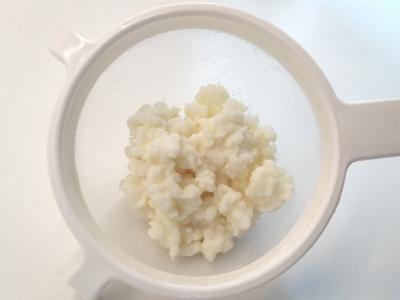Webshop
My page
 See Product Group See Product Group
|
Read more about Kefir |
Add to cart
|
|
|

|
Fresh milk kefir grains for making milk kefir - a fermented milk product that taste a bit like buttermilk with intense sour- and freshness - flavours that intensify the longer it ferments.
Kefir is easily made by adding these grains to fresh milk and leave it at room temperature for 12 to 24 hours. Soon after you may enjoy it like a yogurt.
For easy straining of the kefir we recommend a plastic strainer: Strainer - 10 cm or Strainer - 14 cm
Note: This product may be temporarily out of stock in order for our production to keep up with demands. If this is the case then please check up within a week.
Note: It is only possible to order 1 portion per buy, but if you nurse them well, soon the little grains will grow in numbers and slowly allow you to build a larger portion.
|
Loading...
Content
1 portion = app. ½ tsp. Contents: 50 ml.
UsageKefir grains produce a milk beverage trough a complex interaction between lactic acid bacteria, yeast cells and sugars. When you recieve the grains, place them in a glass with 1 dl milk for 12 hours at room temperature. Cover with a loosely fitted lid or cloth to prevent bacteria from entering and excess gas to escape. You can leave the grains to ferment the milk even longer if you prefer a stronger flavoured kefir. If it finishes up too strong - just add more milk. Expect to repeat this procedure for 7-14 days before you notice any growth. No harm is done if you leave it to ferment too long - if you ferment it up to 24 hours you will notice how the whey seperates from the "white" and a small amount of alcohol may have developed, hence the strong smell. This is alright, you can shake it up and drink it, however it will be somewhat strong flavoured but some people like that. If you divide the grains into smaller bits you increase the surface area and thereby increase their activity - just make sure not to make them so small they will dissapear through the little holes in your sieve or cheese cloth. When the grains have doubled in diameter, it will be x 8 in volume and capacity, hence you can ferment 8 times more milk (8 dl). If the grains at some point grow too much and ferment too fast for your needs, simply divide the portion and delight neighbours and friends with them. The milk kefir grains can be used with other types of milk, like coconut milk, as long as the milk contains sugar. However, they must be revitalized in regular milk containing milk sugar (lactose) for every 3 batches to maintain their activity. DosageContents of 50 ml is intended for 2 dl. 1 portion = ½ tbs kefir grains ferments 1 dl milk but the grains will soon grow and be able to ferment larger portions of milk. If you add a sachet of Kefir starter culture, from time to time, it will help maintain the right balance between lactic acid bacteria and yeast and nice flavouring. You should be cautious if you have known reactions to yeast or alcohol. If you are new to fermented foods you should only ingest small amounts og kefir in the beginning, gradually increasing the amounts. Note om dosering af bakteriekulturer og enzymer
Storage and DurabilityStore refrigerated (do not freeze).
How to preserve the grains:
Kefir grains does not like:
RecipeMaking kefir takes 2 days. Day 1: Place the grains in a clean glass jar at room temperature and cover them in 1 dl milk. Cover with a loosely fitted lid or cloth. Day 2: Transfer the jar to the fridge, perhaps stir or shake it up a little. Day 3: Run the kefir through a sieve into a bowl - make sure it is made from plastic. Clean the jar and place the grains in it once again and add milk. The kefir is ready to be enjoyed right away, but it stores well in the refrigerator too! Adjust the amount of milk and fermenting time, as the grains grow and multiply. For the first 1-2 weeks the tiny grain portion will only ferment up to 1 dl and only become slightly sour. In time this will increase too. Adjust fermenting time according to you preferences and divide the portion at some point when they become too many and ferment too fast. NOTE: If the kefir ferments for sufficient time the milk will seperate into whey and a somewhat solid components part. The somewhat solid components are milk protein and fats mixed with the kefir grains. To separate the kefir grains from the rest you must process the mass using a spoon and a strainer until only the kefir grains remain in the strainer. The kefir grains are quite durable and can withstand rough treatment without being damaged. This way you will be able to produce kefir fermented fresh cheese. BackgroundKefir originates from Russia and Caucasus and is a complex interaction between lactic acid bacteria yeast that produces formations of proteins, fats and sugars looking like tiny little cauliflowers. Despite the similarity with various types of fungal growth, these structures are NOT fungi. The internet flourish with praises about Kefir health benefits. Hjemmeriet holds no account for this and is NOT liable for any side effects caused by ingesting Kefir. There are both pros and cons out there and Kefir may have individual influence. Seek out information and make up your own mind whether Kefir is right for you. Article on documented Kefir influence - Click this link (new window) For further reading we can recommend the following site: Dominic N Anfiteatro. MiscellaneousAt Hjemmeriet we use organic (low fat) milk for the milk kefir. DocumentsFor additional information - please see the following links:Culture OverviewUse the following to understand your possibilities for choosing cultures and enzymes for the production of butter, soured milk or cream, yogurt and cheese. Read the introductory explanations first. This explains the basics you need to understand the range of possibilities. Read this firstTo make dairy products you typically need starter cultures and eventually enzymes and ripening cultures.
Bacteria strains used in starter cultures are classified based on their temperature for optimal growth: A mesophilic starter culture contains mesophilic bacteria strains only. In addition to the mesophilic/thermophilic classification, bacteria strains are divided into classes (O, D, L, T, Y, A and B), depending on specific properties of the bacteria strains. The O, D and L classes are mesophilic. The T, Y, A and B classes are thermophilic. The starter culture tables show which bacteria strains each starter culture includes. Additional information is available for the starter cultures:
The starter cultures contain blends of bacteria strains depending on the style of the dairy product being made. Some of the cultures are shown to contain the same strains of bacteria; however, those cultures are not identical. They each have a different ratio, percentage or contains individual sub-spieces of strains in order to give the desired result. Bacteria strains from class D and L are heterofermentive and will produce lactic acid along with CO2 (gas) and diacetyl and/or other components which will contribute a buttery taste. All other acidifying classes are homofermentive, producing only lactid acid and will contribute a more simple acidic taste. For ripening cultures, proteolysis specifies in which degree the microorganisms breaks down the milk proteins, which contribute to the development of flavour and texture of the product. Lipolysis specifies in which degree the microorganisms breaks down the milk fats, thereby contributing to the development of fatty acid flavour and texture of the product. Suggestions on startersLoading... Culture overviewLoading... MicroorganismsLoading... TipsHer er et forslag til en super smoothie / greenie. Per portion, cirka 3½ dl: ½ avocado Det hele blender i kort tid og hældes på et stort glas, som kan toppes med en spsk. afskallet hampefrø. Varier smoothien efter smag - tilsæt gerne et stykke frosset banan, stykker af friske eller frostne grøntsager. |
||||||||||||||||||||||||||||
|
|





























































































































































































 In stock
In stock  8/0
- Visitors: 1441046 - 1
8/0
- Visitors: 1441046 - 1